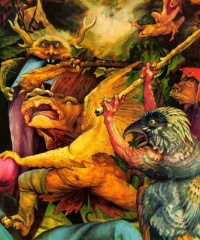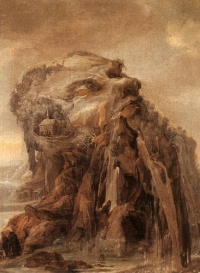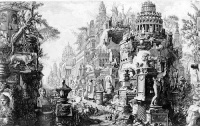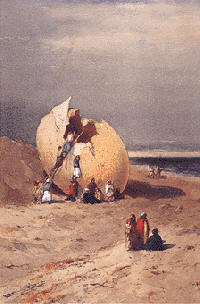Fantastic art
From The Art and Popular Culture Encyclopedia
|
"The four floors of the Museum will be devoted to the exhibition, which will include more than 700 objects [...] ranging from such extremes as Giovanni di Paolo and Leonardo da Vinci of the fifteenth century to Walt Disney, Rube Goldberg and Thurber of the twentieth century, and including such famous names both old and modern as Hieronymus Bosch, Duerer, Arcimboldo, Hogarth, William Blake, Cruickshank, Lewis Carrol, Daumier, Delacroix, Edward Lear, Redon, Chagall, de Chirico, Duchamp, Picasso, Arp, Dali, Ernst, Grosz, Magritte, Miro, Klee, Man Ray, Tanguy, Peter Blume, Georgia O'Keeffe, and Alexander Calder."--Fantastic Art, Dada, Surrealism (1936) "Painting mastered a third domain: the fantastic. As long as the spirit of realism prevailed, artists had painted only what they saw, looking with suspicious eye upon anything beyond this. But when, in consequence of the ecclesiastical reaction, metaphysical tendencies followed the realistic, the fantastic element at once appeared. It was developed to an even greater extent in the North than in Italy, because the fantastic is a more important element in the northern than in the Italian character. The art of engraving, which, with greater facility than the brush, follows the spirit into the world of fable, became of determinative importance. After Schongauer in his Temptation of St. Antony had first modestly entered the territory the artists who followed him took possession of the entire legendary domain. "--The History of Painting: From the Fourth to the Early Nineteenth Century (1893/94) by Richard Muther |
|
Related e |
|
Featured: |
Fantastic art is an art genre. The parameters of fantastic art have been tentatively defined in the scholarship on the subject ever since the 19th century. However, the genre had to wait for the inter war period to be mentioned by name at the "Fantastic Art, Dada, Surrealism" exhibition of winter 1936/1937 at the Museum of Modern Art in New York City, which displayed pre-surrealist works such as The Titan's Goblet by Thomas Cole.
Fantasy has been an integral part of art since its beginnings, but has been particularly important in mannerism, magic realist painting, romantic art, symbolism, surrealism and lowbrow. In French, the genre is called le fantastique, in English it is sometimes referred to as visionary art, grotesque art or mannerist art. It has had a deep and circular interaction with fantasy literature.
Fantastic art explores fantasy, "space fantasy" (a sub-genre which incorporates subjects of alien mythology and/or alien religion), imagination, the dream state, the grotesque, visions and the uncanny, as well as so-called "Goth" art. Being an inherent genre of Victorian Symbolism, modern fantastic art often shares its choice of themes such as mythology, occultism and mysticism, or lore and folklore, and generally seeks to depict the [inner life] (nature of soul and spirit).
Fantastic art should not be confused with fantasy art, which is the domain of science-fiction and fantasy illustrators such as Boris Vallejo and others.
Contents |
Historic artists and fine artists
Fantastic art is a loosely defined art genre. However, the first "fantastic" artist is generally believed to be Hieronymus Bosch.
Middle Ages and Renaissance
The first "fantastic" artist is generally said to be Hieronymus Bosch. Other medieval and Renaissance artists who have been labeled fantastic include Matthias Grünewald, Hans Baldung Grien, Brueghel and Giuseppe Arcimboldo.
In Italy, the fashion for grotesque art starts.
17th century
Jacques Callot, but also the Mannerist and baroque grotesque and the auricular style and the Bizzarie di varie figure (1624) by Giovanni Battista Braccelli.
18th century
Giovanni Battista Piranesi, Henry Fuseli, Francisco de Goya.
But also sets of ornamental prints such as Les costumes grotesques et les métiers (c. 1695) by Nicolas de Larmessin II and Mascarade à la Grecque (1771) by Ennemond Alexandre Petitot and the fantastic architecture of Étienne-Louis Boullée, Claude Nicolas Ledoux and Jean-Jacques Lequeu.
19th century
William Blake, Gustave Doré, Gustave Moreau, Arnold Böcklin, Odilon Redon, Max Klinger. Lesser known artists include Charles-Frédéric Soehnée. Artists working in the print medium were Grandville.
20th century
Salvador Dalí, Rudolf Hausner, Johfra, H. R. Giger, Odd Nerdrum, Mati Klarwein, Ernst Fuchs and Paul Rumsey.
Also deserving to be mentioned is Artforms of Nature (1904) by Ernst Haeckel.
United States
In the United States in the 1930s, a group of Wisconsin artists inspired by the Surrealist movement of Europe created their own brand of fantastic art. They included Madison, Wisconsin-based artist John Wilde; Karl Priebe of Milwaukee and Gertrude Abercrombie of Chicago. Their art combined macabre humor, mystery and irony which was in direct and pointed contradiction to the American Regionalism then in vogue.
In postwar Chicago the art movement Chicago Imagism produced many fantastic and grotesque paintings, which were little noted because they did not conform to New York abstract art fashions of the time. Major imagists include Roger Brown, Gladys Nilsson, Jim Nutt, Ed Paschke, and Karl Wirsum.
Historic artists and fine artists
Many artists have produced works which fit the definition of fantastic art. Some, such as Nicholas Roerich, worked almost exclusively in the genre, others such as Hieronymus Bosch, who has been described as the first "fantastic" artist in the Western tradition, produced works both with and without fantastic elements, and for artists such as Francisco de Goya, fantastic works were only a small part of their output. Others again such as René Magritte are usually classed as Surrealists but use fantastic elements in their work. It is therefore impossible to give an exhaustive list of fantastic artists, but a selection of major and influential figures is listed below.
16–18th centuries
- Giuseppe Arcimboldo
- William Blake
- Hieronymus Bosch
- Brueghel
- Monsù Desiderio
- Henry Fuseli
- Hans Baldung Grien
- Matthias Grünewald
- Giovanni Battista Piranesi
19th century
- Arnold Böcklin
- Bouguereau
- Gaston Bussiere
- Thomas Cole
- Walter Crane
- Richard Dadd
- Evelyn De Morgan
- Gustave Doré
- Caspar David Friedrich
- Francisco de Goya
- Edward Burne-Jones
- Max Klinger
- John Martin
- Gustave Moreau
- Albert Robida
- Viktor Vasnetsov
- Mikhail Vrubel
- John William Waterhouse
- George Frederic Watts
20th century
- John Bauer
- Johfra Bosschart
- Marc Chagall
- Giorgio de Chirico
- Salvador Dalí
- Jean Delville
- Paul Delvaux
- Max Ernst
- M. C. Escher
- Hugh Ferriss
- Warwick Goble
- Thomas Häfner
- Rudolf Hausner
- Alfred Kubin
- René Magritte
- Abraham Mintchine
- Maxfield Parrish
- Arthur Rackham
- Odilon Redon
- Nicholas Roerich
- Henri Rousseau
- Franz Sedlacek
- Yves Tanguy
- Bridget Bate Tichenor
- Clovis Trouille
Twentieth century
The rise of fantasy and science fiction "pulp" magazines demanded artwork to illustrate stories and (via cover art) to promote sales. This led to a movement of science fiction and fantasy artists prior to and during the Great Depression, as anthologised by Vincent Di Fate, himself a prolific SF and space artist.
In the United States in the 1930s, a group of Wisconsin artists inspired by the Surrealist movement of Europe created their own brand of fantastic art. They included Madison, Wisconsin-based artists Marshall Glasier, Dudley Huppler and John Wilde; Karl Priebe of Milwaukee and Gertrude Abercrombie of Chicago. Their art combined macabre humor, mystery and irony which was in direct and pointed contradiction to the American Regionalism then in vogue.
In postwar Chicago, the art movement Chicago Imagism produced many fantastic and grotesque paintings, which were little noted because they did not conform to New York abstract art fashions of the time. Major imagists include Roger Brown, Gladys Nilsson, Jim Nutt, Ed Paschke, and Karl Wirsum.
After 1970, modern western fantasy is influenced by illustrations from Conan the Barbarian and or the French Heavy Metal magazine.
Contemporary and mid-century artists
- Zdzisław Beksiński
- Arik Brauer
- Roger Dean
- Vincent Di Fate
- Ed Emshwiller
- Frank Frazetta
- Brian Froud
- Ernst Fuchs
- H. R. Giger
- Jean Giraud
- Mati Klarwein
- Odd Nerdrum
- Octavio Ocampo
- Luis Royo
- Mark Ryden
- Maurice Sendak
- Brian Selznick
- Luigi Serafini
- Wojciech Siudmak
- Boris Vallejo
- Robert Venosa
- Michael Whelan
- Jacek Yerka
Historiography
The historiography of fantastic art began when the Surrealists started to inspect their roots and drew up a list of their predecessors, see Proto-Surrealism.
Bibliography
- L'art fantastique (1961) - Marcel Brion
- Au cœur du fantastique (1965) - Roger Caillois
- Dreamers of Decadence: Symbolist Painters of the 1890s (1969) - Philippe Jullian
- Quatre siècles de Surréalisme (1973) by Pierre Belfond
- The Occult in Art (1990) by Owen S. Rachleff
- Les peintres du fantastique (1996) by André Barret
See also
- Alchemy in art and entertainment
- Dream art
- Grotesque art
- Phantasticus
- Surrealism
- Neosurrealism
- Fantastic Art Centre
- Society for the Art of Imagination
_by_Arcimboldo_in_the_Kunsthistorisches_Museum_Wien.jpg)





_.jpg)




